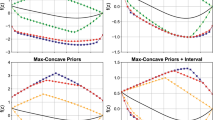Abstract
In this paper we present a methodology for finding tight convex relaxations for a special set of quadratic constraints given by bilinear and linear terms that frequently arise in the optimization of process networks. The basic idea lies on exploiting the interaction between the vector spaces where the different set of variables are defined in order to generate cuts that will tighten the relaxation of traditional approaches. These cuts are not dominated by the McCormick convex envelopes and can be effectively used in conjunction with them. The performance of the method is tested in several case studies by implementing the resulting relaxation within a spatial branch and bound framework.
Similar content being viewed by others
References
Quesada I., Grossmann I.E.: Global optimization of bilinear process networks with multicomponent flows. Comput. Chem. Eng. 19(12), 1219–1242 (1995)
Horst R., Tuy H.: Global Optimization Deterministic Approaches, 3rd edn. Springer-Verlag, Berlin (1996)
McCormick G.P.: Computability of global solutions to factorable nonconvex programs. Part I: convex underestimating problems. Math. Program. 10, 146–175 (1976)
Tawarmalani M., Sahinidis N.: Convexification and Global Optimization in Continuous and Mixed-Integer Nonlinear Programming. Kluwer Academic Publishers, Dordrecht (2002)
Anstreicher K.M.: Semidefinite programming versus the reformulation-linearization technique for nonconvex quadratically constrained quadratic programming. J. Glob. Optim. 43(2–3), 471–484 (2009)
Narasimhan S.: Data Reconciliation & Gross Error Detection: An Intelligent Use of Process Data. Gulf Professional Publishing, Houston (2001)
Zamora J.M., Grossmann I.E.: A branch and bound algorithm for problems with concave univariate, bilinear and linear fractional terms. J. Glob. Optim. 14(3), 217–249 (1999)
Drud S.A.: CONOPT—a large-scale GRG code. ORSA J. Comput. 6, 207–216 (1992)
Sherali H.D., Alameddine A.: A new reformulation linearization technique for bilinear programming problems. J. Glob. Optim. 2, 379–410 (1992)
Kreiszig E.: Advanced Engineering Mathematics. Wiley, New York (2001)
Al-Khayyal F.A., Falk J.E.: Jointly constrained biconvex programming. Math. Oper. Res. 8(2), 273–286 (1983)
Liberti L., Pantelides C.C.: An exact reformulation algorithm for large nonconvex NLPs involving bilinear terms. J. Glob. Optim. 36(2), 161–189 (2006)
Gounaris C.E., Misener R., Floudas C.A.: Computational comparison of piecewise-linear relaxations for pooling problems. Ind. Eng. Chem. Res. 48(12), 5742–5766 (2009)
Wicaksono D.S., Karimi I.A.: Piecewise MILP under- and overestimators for global optimization of bilinear programs. AICHE J. 54, 991–1008 (2008)
Author information
Authors and Affiliations
Corresponding author
Rights and permissions
About this article
Cite this article
Ruiz, J.P., Grossmann, I.E. Exploiting vector space properties to strengthen the relaxation of bilinear programs arising in the global optimization of process networks. Optim Lett 5, 1–11 (2011). https://doi.org/10.1007/s11590-010-0228-4
Received:
Accepted:
Published:
Issue Date:
DOI: https://doi.org/10.1007/s11590-010-0228-4




